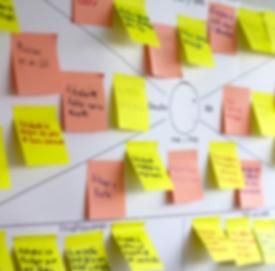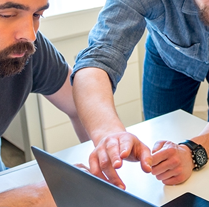BLOG

Design Thinking Phase Four: Prototype
From planning, prototyping, and testing your ideas to implementing them, the journey of developing a new product is a combination of different steps. The design thinking process comprises five steps; empathize, define, ideate, prototype, and test. Being fourth in the line, after ideation sessions, the prototyping phase saves the design team’s time and money by revealing to them how the user would think and feel about their products or services while allowing them to address any uncertainties around the idea. Simply put, creating a prototype takes the risk out of innovation, helping you develop well-functioning and bug-free software. Here is everything you need to know about design thinking prototypes.
What Is a Prototype in Design Thinking?
Design thinking can be defined as both a process and an ideology used to solve complex real-world problems in a user-centric way. Similar to creating a UX (User Experience) design, the design thinking prototype phase focuses heavily on the user front, helping you create a product that provides the best user experience to potential customers.
Prototyping is a scaled-down version of your software (final product). During the early stages of the design thinking prototype, the design team creates several inexpensive, simpler versions of the product to test their idea and design before actually investing time and money. Creating a prototype is crucial for evaluating the idea and its formalization. The primary purpose of the design thinking prototype phase is to have a tangible visual representation of the design solutions discussed during the ideation session within the team. In simpler words, “prototyping is the way to bring ideas to life.”
Ranging from fully functional, interactive digital prototypes to simpler paper models, design thinking prototypes come in different sizes and shapes. Some common types of prototyping are as follows:
High-Fidelity Prototyping
High-fidelity prototyping looks and operates closer to the final product. Take the example of a 3D plastic model consisting of movable parts. The high-fidelity prototyping allows the design team to interact, use and manipulate the device in the same manner as the end product. This form of prototyping allows the team to conduct a more rigorous and compelling testing phase to be more confident about how the user will respond to the product or service. Software that one can use include Adobe Illustrator and Sketch.
Low-Fidelity Prototyping
Being a more simplified form of prototyping, Low-fidelity prototyping helps the design team create a basic model of the product being tested. During low-fidelity prototyping, the team will analyze the problem statement and develop (construct) a similar final product while using materials such as metal, wood, and even plastic. These easily made and cheap models are only created to visualize the functioning of the design solutions. Examples of low-fidelity prototyping and testing include Storyboarding, Sketching, Wizard of Oz, and Card Sorting.
Paper Prototypes
Paper prototypes are developed to help design teams realize concepts and test their design solutions. The team usually creates paper-shots (screenshots drawn on paper) to help determine the final product. It speeds up the brainstorming process, helping find the best design solution possible.
Why Is a Prototype Important in Design Thinking?
Design thinking prototype generates empathy for potential customers. In other words, just like manufacturers keep the consumer’s needs in mind when creating a product, the designers need to keep the user needs in mind when developing software, and the design thinking prototype phase makes it all possible. Some benefits of prototyping are as follows:
Enhanced Quality
Allowing the design team to conduct testing of the software, inspect its navigation, and analyze the site’s information, the design thinking prototype ensures the high quality of your product.
Easy and Quick
Whether on a piece of paper, or a 3D working model, the design team can proficiently develop a ready-to-implement prototype if they understand the functionality and logic of the product.
Effective Presentation of the Idea to the User
Design thinking prototype allows you to present the future product to potential uses before the actual launch.
Stimulate the Final Product
Prototyping helps create a model for the final product, helping lure more users to invest in the product. This also helps in discovering design errors and the efficiency of the product.
What Is the Output of the Prototype Phase in Design Thinking?
The design thinking prototype phase is a quick and easy way to bring the client’s requirements and ideas to life. The prototyping and user testing phases help you determine the most efficient and effective solutions, allowing you to solve problems in the early stages without wasting your time and money. As a result of the constant feedback, and design iterations, you, along with your design team, will develop a perfectly working model according to the client’s unique needs. Once you have a well-functioning prototype, all you need to do is develop it on a larger scale.
Designers today aren’t only tasked to develop traditional design projects but are expected to create designs following a more human-centric approach. The design thinking prototype process helps the design team achieve their goal in an organized yet efficient way. Being a back-and-forth process allows the designers to connect to the client and get better insight into their creation, resulting in a better final product.
YOU MAY ALSO LIKE

Feb 17th 2022 - Erhan B.
What is Design Thinking in Software Development

May 18, 2022 - Erhan B.
The Foundation of the Design Thinking Process: Empathize


